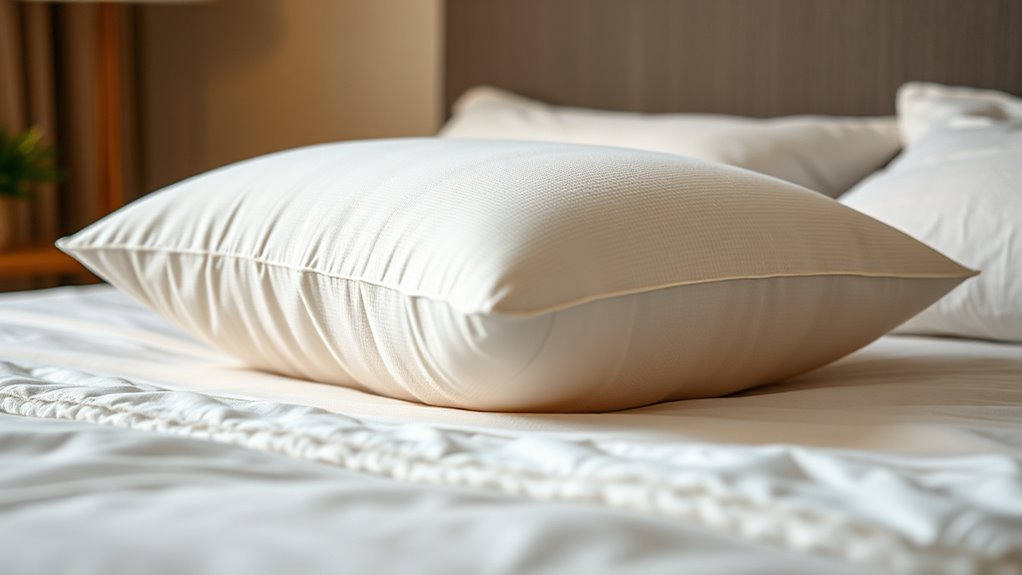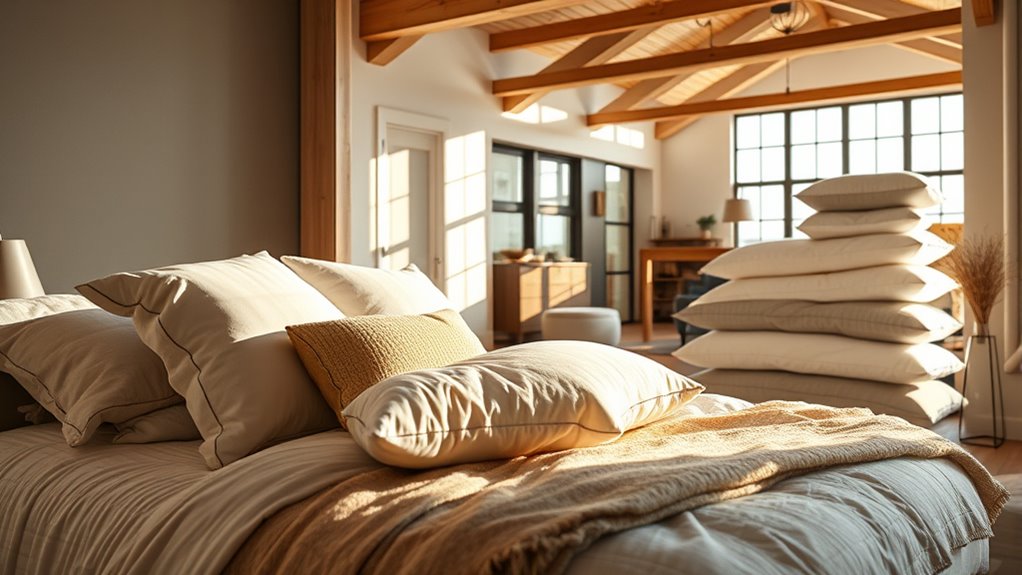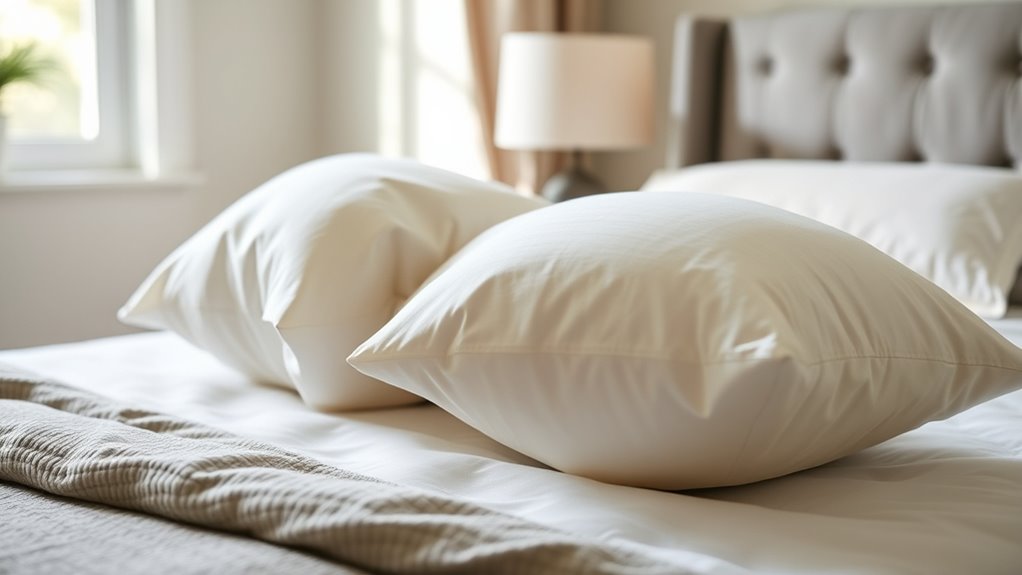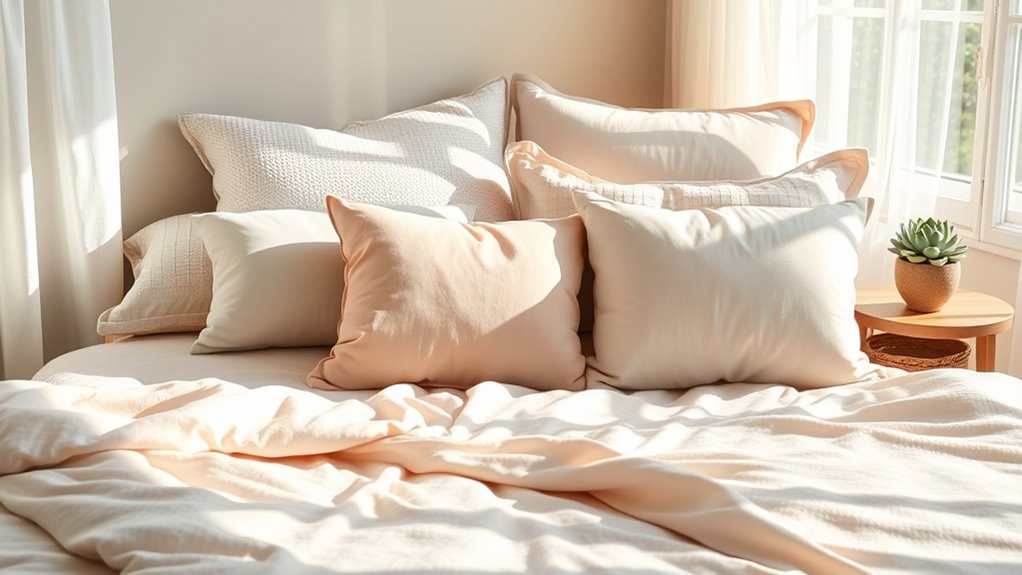Pillow loft is the height or thickness of your pillow when fluffed and ready for use. It affects your sleep comfort by supporting your head and neck properly, keeping your spine aligned, and influencing temperature—all depending on your sleep position and pillow material. Too high or low loft causes discomfort and misalignment. If you want to learn how to choose and adjust the perfect loft for better rest, keep exploring these helpful tips.
Key Takeaways
- Pillow loft refers to the pillow’s height or thickness when fluffed, impacting support and sleep comfort.
- Proper loft maintains natural neck and spine alignment, reducing pain and improving sleep quality.
- Different sleep positions require specific loft levels: medium for back, high for side, low for stomach sleepers.
- Adjustable loft options help customize support, enhancing comfort and reducing neck or shoulder strain.
- An unsuitable loft can cause discomfort, misalignment, and morning stiffness, affecting overall wellness.
What Is Pillow Loft and Why Does It Matter?

Pillow loft refers to how thick or tall a pillow is when it’s fluffed and ready to use. It directly affects your sleep experience because the pillow material influences its loft and how it maintains shape. For example, memory foam tends to have a higher loft and provides more support, while down or microfiber offers a softer, adjustable height. Loft also impacts sleep temperature; thicker pillows can trap heat, making you feel warmer during the night, especially if the pillow material retains heat. Choosing the right loft depends on your sleeping position and personal preferences. A proper loft ensures your head and neck are well-aligned, which promotes better sleep quality and reduces discomfort. Ultimately, understanding pillow loft helps you find a more comfortable, supportive sleep setup.
How Pillow Loft Influences Sleep Comfort and Alignment

The right pillow loft plays a crucial role in ensuring your sleep comfort and proper spinal alignment. When your pillow’s loft matches your sleep surface and pillow firmness needs, you reduce strain on your neck and shoulders. A loft that’s too high or too low can cause misalignment, leading to discomfort and disrupted sleep. Your ideal loft supports the natural curve of your neck, keeping your spine aligned. Use this table to understand how loft relates to your sleep surface and firmness:
| Sleep Surface | Pillow Firmness | Recommended Loft |
|---|---|---|
| Firm | Soft | Low to Medium |
| Soft | Firm | Medium to High |
| Soft | Soft | Low |
| Firm | Firm | Medium to High |
| Medium | Medium | Medium |
Matching loft with your sleep surface and firmness ensures better comfort and spinal health.
Different Types of Loft and Which Is Best for Your Sleep Style

Choosing the right loft depends on your sleep style and personal preferences. If you sleep on your back, a medium loft pillow with supportive pillow material helps maintain proper neck alignment. Side sleepers benefit from a higher loft pillow that fills the space between your shoulder and head, providing extra support. For stomach sleepers, a low loft pillow made of softer pillow material prevents neck strain and keeps your spine aligned. Your sleep position influences the ideal pillow loft, so consider this carefully. Different pillow materials, like memory foam or down, also affect loft and comfort, so choose based on your softness preference and support needs. Ultimately, selecting the right loft type improves sleep quality and reduces discomfort, tailored specifically to your sleep style.
Signs Your Pillow’s Loft Isn’t Supporting You Properly

When your pillow’s loft doesn’t match your sleep style, signs of discomfort often become noticeable. If your pillow feels too flat or too lofty, it’s likely affecting your sleep quality. You may experience:
- Neck or shoulder pain, indicating your pillow firmness isn’t providing proper support for your sleep position.
- Frequent tossing and turning, as your head and neck aren’t aligned comfortably.
- Morning stiffness or headaches, showing your pillow’s loft isn’t maintaining proper spinal alignment.
These signs suggest your pillow’s loft isn’t supporting your natural sleep position. A mismatch in pillow firmness and loft can lead to discomfort and disrupted sleep. Recognizing these cues helps you understand when it’s time to reassess your pillow choice.
Tips for Choosing and Adjusting Your Pillow Loft for Better Rest

To improve your sleep quality, choosing a pillow with the right loft that matches your sleep posture and preferences is vital. For back sleepers, a medium loft with balanced pillow firmness provides support without straining your neck. Side sleepers benefit from a higher loft to fill the space between your shoulder and head, ensuring proper spinal alignment. Stomach sleepers should opt for a lower loft pillow with softer pillow firmness to prevent neck strain. Adjust your pillow by adding or removing filling if possible, or using pillow inserts to customize height. Pay attention to how your neck and spine feel throughout the night. Finding the right loft for your sleep posture helps maintain proper alignment, reduces discomfort, and promotes restful sleep.
Frequently Asked Questions
How Often Should I Replace My Pillow Based on Loft Changes?
Your pillow’s loft is like a reputation at stake—once it flattens, it’s time for a change. Generally, you should replace your pillow every 1-2 years, especially if the loft no longer supports your sleep position or if the pillow material shows signs of wear. Regularly assess its shape; a flattened pillow can cause neck pain and discomfort, so stay proactive to keep your sleep quality high.
Can Pillow Loft Impact Allergies or Respiratory Issues?
Yes, pillow loft can impact allergies and respiratory issues. If your pillow’s loft declines, it can trap more dust mites, mold, and allergens, worsening allergy symptoms. Maintaining good pillow hygiene by regularly replacing or fluffing your pillow helps mitigate allergies. Choosing the right loft for your sleep position also improves airflow, reducing respiratory discomfort. Prioritize loft and hygiene to create a healthier sleep environment and minimize allergy flare-ups.
Does Pillow Loft Affect Side Versus Back Sleeping Differently?
Your pillow loft can impact your sleep position differently; a firmer pillow with higher loft often supports side sleeping better by keeping your neck aligned, reducing strain. For back sleeping, a medium loft pillow offers comfort without forcing your head forward. Choosing the right pillow firmness and loft tailored to your sleep position helps improve comfort, prevents neck pain, and promotes restful sleep.
Are Adjustable Pillows Better for Maintaining Optimal Loft?
Like a chameleon blending seamlessly into its environment, an adjustable pillow adapts to your sleep position, making it easier to find the perfect balance of pillow firmness and loft. They’re better for maintaining ideal loft because you can customize height and support, ensuring your neck stays aligned regardless of whether you sleep on your side or back. This flexibility helps you wake up refreshed, with comfort tailored precisely to your needs.
How Does Pillow Loft Influence Neck and Shoulder Pain?
Your pillow loft considerably impacts neck and shoulder pain by supporting your sleep position and pillow material choice. A loft that’s too high or low can strain your neck, especially if you sleep on your side or back. Opt for a pillow with adjustable loft to match your sleep position, and choose a material that offers proper support and comfort. This helps maintain proper spinal alignment, reducing discomfort and promoting restful sleep.
Conclusion
Choosing the right pillow loft transforms your sleep experience. It supports your neck, aligns your spine, and guarantees comfort throughout the night. When you select the perfect loft, you wake up refreshed, pain-free, and ready to face the day. Adjust it to match your sleep style, recognize signs it’s not working, and prioritize your wellness. Because a well-chosen loft isn’t just about sleep — it’s about feeling better, living better, and waking up energized each morning.









